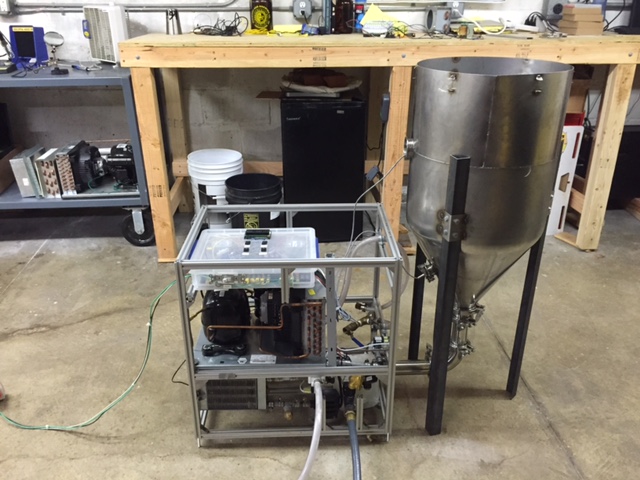homemaltster
Well-Known Member
My brewing buddy and I started working on a little project almost 2 years ago. As you all know, those little projects can sometimes spiral out of control...
We had a simple quest: to make a truly local, truly good beer from scratch. Finding the ingredients was our first stumbling block. We already had access to some hop plants, but quickly learned access to good quality malting barley isnt an easy thing to get. We knew a thing or two about farming, so we decided that if we couldnt buy it, we could grow our own grain, malt it, and brew with it.
Malting wasnt as easy as wed hoped either. Like other people that have tried their hand at home malting, we cobbled together a simple setup: some buckets, a fridge, and a homemade kiln. Our setup was as janky as they come, but we made malt and had fun doing it. The biological journey from barley to malt was fascinating, and interacting with our equipment was exciting.
After the first couple uses, we quickly realized our equipments limitations. Getting up at 3 AM to turn and moisten the grain got old fast. We decided to automate the process to allow us to malt without spending all of our time doing it.
The bigger problem was that our setup didnt have the climate control capabilities to consistently make good malt. If the weather wasnt just right (so, nearly always), the sprouting process got out of control, and molding could happen. To make high-quality malt every month of the year, we had to do something to simulate the cave-like conditions that are ideal for germinating grain.
So we built a machine to do just that. Now we just upload a recipe to it, dump in the grain we grew with a farmer friend, check on it at least once a day, and look at the malting data thats automatically logged online. The machine maintains optimal conditions, and weve been really happy with the malt weve been making.
Were still refining the machine, but weve decided to found a startup to try to bring our baby to market and share the fun weve discovered with others. Weve found home brewing to be even more creative and fulfilling since we started making our own malt, and we think exciting things will happen to beer if our community starts playing around with the soul of beer.
As we said before, weve been working on this for almost 2 years, so a lot has happened. Weve gone so far down the malt rabbit hole and have become truly hooked. Its been a blast, and we really want to share everything weve learned - about barley, farming, malting, equipment, beer, and more - with our fellow brewers. More to come soon!
Cant talk about equipment for that long without sharing a picture here it is!

We had a simple quest: to make a truly local, truly good beer from scratch. Finding the ingredients was our first stumbling block. We already had access to some hop plants, but quickly learned access to good quality malting barley isnt an easy thing to get. We knew a thing or two about farming, so we decided that if we couldnt buy it, we could grow our own grain, malt it, and brew with it.
Malting wasnt as easy as wed hoped either. Like other people that have tried their hand at home malting, we cobbled together a simple setup: some buckets, a fridge, and a homemade kiln. Our setup was as janky as they come, but we made malt and had fun doing it. The biological journey from barley to malt was fascinating, and interacting with our equipment was exciting.
After the first couple uses, we quickly realized our equipments limitations. Getting up at 3 AM to turn and moisten the grain got old fast. We decided to automate the process to allow us to malt without spending all of our time doing it.
The bigger problem was that our setup didnt have the climate control capabilities to consistently make good malt. If the weather wasnt just right (so, nearly always), the sprouting process got out of control, and molding could happen. To make high-quality malt every month of the year, we had to do something to simulate the cave-like conditions that are ideal for germinating grain.
So we built a machine to do just that. Now we just upload a recipe to it, dump in the grain we grew with a farmer friend, check on it at least once a day, and look at the malting data thats automatically logged online. The machine maintains optimal conditions, and weve been really happy with the malt weve been making.
Were still refining the machine, but weve decided to found a startup to try to bring our baby to market and share the fun weve discovered with others. Weve found home brewing to be even more creative and fulfilling since we started making our own malt, and we think exciting things will happen to beer if our community starts playing around with the soul of beer.
As we said before, weve been working on this for almost 2 years, so a lot has happened. Weve gone so far down the malt rabbit hole and have become truly hooked. Its been a blast, and we really want to share everything weve learned - about barley, farming, malting, equipment, beer, and more - with our fellow brewers. More to come soon!
Cant talk about equipment for that long without sharing a picture here it is!





















![Craft A Brew - Safale BE-256 Yeast - Fermentis - Belgian Ale Dry Yeast - For Belgian & Strong Ales - Ingredients for Home Brewing - Beer Making Supplies - [3 Pack]](https://m.media-amazon.com/images/I/51bcKEwQmWL._SL500_.jpg)







































